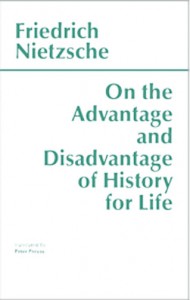 |
Friedrich Nietzsche. On the Advantage and Disadvantage of History for Life. First published in 1874. Cambridge, Mass.: Hackett Publishing Co., 1980.
Nietzsche wrote this 58-page zinger before he turned 30, but long after he had sensed that there was something deeply wrong with the culture in which he had been raised. His booklet begins, like disaffected adolescents everywhere, with hatred—for all of the usual suspects: authority, hypocrisy, convention and general dim-wittedness. Almost immediately, Nietzsche puts his anger to good use, sniffing out what is living and dead in the culture around him; clearing some space for individuals to do their own things; and, ultimately, arriving at love as the touchstone of art, life and every other DIY enterprise worth doing. There’s nothing sappy about Nietzsche’s valorization of passion, just the wisdom that without intimacy art doesn’t stand a chance. Although published three years after the German Empire was formed, his essay feels as if it were written yesterday, its critique of falseness as applicable to our managerial culture as it was to his.
|